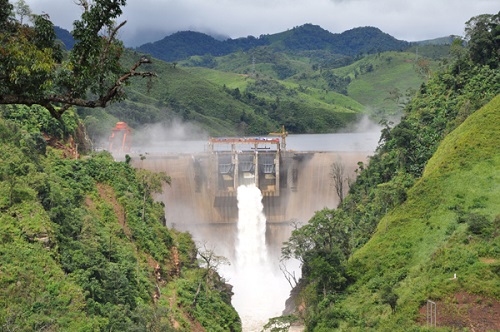Managing The Natural Resource Development Boom
Source: Vientiane Times
Laos is a resource rich economy in terms of mining and hydropower, although there have been very few studies on the matter, and the Lao government has not yet designed relevant policy options for managing the country’s resources.
To promote broad-based growth in Laos, it is important to consider the policy options, according to the Organisation for Economic Cooperation and Development (OECD).
According to the World Energy Council, Laos has the potential to develop 18 gigawatts (GW) of hydropower capacity, the equivalent of around 63 terawatt-hours (TWh) per year, assuming a 40 percent capacity factor.
The country has 14 operational projects and 12 projects under construction, according to the OECD report on the Economic Outlook for Southeast Asia, China and India 2016 that was delivered at the recent Asean-BIS meeting in Vientiane.
Laos’ electricity generation history started in 1971 with the commissioning of the Nam Ngum 1 dam, which had an installed capacity at that time of just 30 megawatts (MW), but capacity had increased to 150 MW by 1987.
As of the early 1990s, only 20 percent of Nam Ngum’s generation was consumed domestically, primarily to supply Vientiane, with the balance exported to Thailand.
Most hydropower projects, particularly the large ones, are independent power producer projects for export, and the majority of export projects are developed to supply Thailand.
Export projects are backed by a Memorandum of Understanding between the Lao government and the governments of interested countries mainly Thailand, with an export target of 7,000MW by 2050.
An agreement with Vietnam also exists for electricity exports of up to 3,000MW by 2020, while an agreement with Cambodia provides for only a small capacity (around 15MW).
Revenues to the Lao government come from many different sources, including land fees, royalties, profit tax, turnover tax, personal income tax, dividend withholding tax, import and export duties, fees (buying and selling of shares, licence fees, technical service fees), and contributions to funds (for environmental protection, community development, human resources, sustainable development and project monitoring).
Apart from taxes and royalties, the government also receives dividend payments from hydropower operations in which it holds an equity stake, OECD reported.
Laos is rich in mineral resources and the country has more than 500 mineral deposits (World Bank, 2006). The two biggest mining projects are Phu Bia mining and Lane Xang minerals.
Each company has sufficient mineral resources for at least ten years of production, has maintained or added to its resource base annually, has a successful track record of discovering new mineral occurrences, and spends US$25-45 million annually on Lao exploration and evaluation of discoveries.
This can be expected to sustain the level of production and revenues from tax royalties, the OECD noted.
In 2001, 48 companies were investing in the mining sector in Laos. In 2012, there were 290 projects, of which 107 involved prospecting, 125 exploration and 58 mining.
From 2005 to 2013, the mining sector contributed more than 2 percent annually to the country’s real growth rate of about 7 percent.
On the fiscal side, the combined mining and hydro contribution to total government revenues is estimated to have grown by more than 20 percent over the same period.
Tax revenues from resources (profit tax and royalties from mining, and other resource revenue) have increased as a percentage of gross domestic products (GDP) since around fiscal year (FY) 2005/06 and peaked at around 3 percent of GDP in FY2007/2008.
Resource tax revenue reached 2.5 percent of GDP in FY2010/11 partly due to favourable gold and copper prices in international markets.

